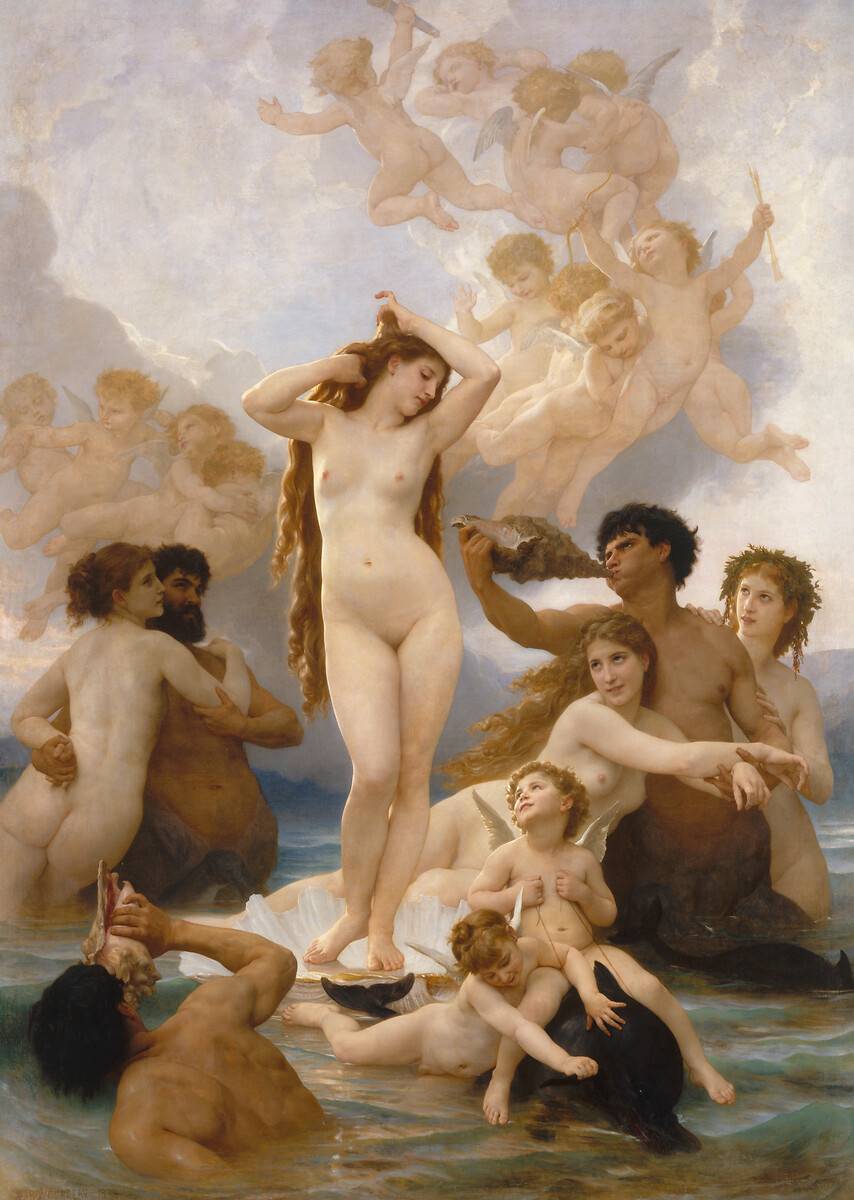Shop art print and framed art The Birth of Venus by William Bouguereau
Customise
Your art print
The Birth of Venus OF William Bouguereau
The Birth of Venus
The Birth of Venus by William-Adolphe Bouguereau: A return to Antiquity in a changing France
William-Adolphe Bouguereau's Birth of Venus, completed in 1879, was part of a French artistic context marked by a desire to revive classical ideals of beauty, while meeting the aspirations of a bourgeois public eager for aestheticised representations. The end of the 19th century saw France oscillating between the upheavals of industrialisation and nostalgia for an idealised past. The Académie des Beaux-Arts, the dominant institution, advocated a return to order and tradition, favouring mythological and historical subjects treated with impeccable technique. Bouguereau, an emblematic figure of this academic movement and then excelling in the representation of idealised female nudes, embodying a vision of timeless beauty, offers a vision of Venus, goddess of love, seduction, female beauty in Roman mythology.
Influence of Greek and Roman mythology in The Birth of Venus by William-Adolphe Bouguereau
The mythological subject of this painting, evident at first glance, offers a depiction of the goddess of love, Venus (also called Aphrodite by the Greeks), being born from the waters to rise into the air surrounded by nymphs and putti. This scene is directly inspired by Roman mythology and the stories that tell of the birth of the goddess, an important element in the ancient world.
The other figures in the painting also refer to the legendary creatures of these ancient mythologies: there are tritons (fish-men) blowing into shells, symbolising the call to life.
Description of The Birth of Venus by William-Adolphe Bouguereau
This monumental work, 300 cm high by 217 cm wide, housed at the Musée d'Orsay in Paris, offers the viewer a balanced and teeming composition in which light plays a key role. The scene takes place in an idyllic seascape, bathed in golden light that accentuates the softness of the forms and the sensuality of the bodies.
The colour palette, dominated by pastel tones and pearly shades, creates a dreamlike, poetic atmosphere. The arrangement of the figures, arranged in an arc around the goddess, gives the whole an impression of movement and lightness, reinforced by the momentum of the waves and the breath of the wind filling the sails. The artist has captured all the splendour of the goddess, at once sensual and angelic, surrounded by other divine beings.
Venus, incarnation of divine beauty in this painting by William-Adolphe Bouguereau
At the centre of this composition, Venus, goddess of love and beauty, emerges from the waves like a precious pearl. Her nude body, of ideal proportions, is modelled with remarkable anatomical precision. The whiteness of her skin contrasts with her flamboyant hair, a symbol of passion and sensuality, while her face, imbued with serenity and grace, embodies the ideal of feminine beauty according to the classical canons of the time. She is greeted by a host of mythological figures: Tritons blowing their conches, voluptuous Nereids, mischievous Lovers fluttering in the air. All celebrate the advent of the goddess, creating an atmosphere of joy and exaltation.
The Birth of Venus by William-Adolphe Bouguereau: An allegory of love and fertility
Beyond its aesthetic dimension, The Birth of Venus is rich in symbolism. The sea, the goddess's cradle, evokes the creative power of nature and fertility. The shell on which Venus stands symbolises femininity and birth. The roses, attributes of the goddess, represent love and beauty, while the putti, armed with their arrows, recall the power of love, capable of touching all hearts. The golden light that bathes the scene evokes the divine dimension of Venus, born from the foam of the waves and bearing a message of harmony and beauty.
A popular success and lasting influence for The Birth of Venus by William-Adolphe Bouguereau
The Birth of Venus was a resounding success from the moment it was presented at the 1879 Salon, establishing Bouguereau as one of the undisputed masters of academic painting. This work, emblematic of his style, helped to strengthen his reputation and ensure his fortune. Although modern art subsequently rejected academicism as too conventional and out of touch with the realities of its time, The Birth of Venus nevertheless remains an inescapable reference in the history of art. It testifies to Bouguereau's technical virtuosity, and his ability to integrate the codes of academic art while bringing them a certain modernity, and to create images of ideal beauty, capable of touching the public with their sensuality and poetry.
This work continues to inspire contemporary artists, who revisit the myth of Venus through new interpretations, while acknowledging the aesthetic power of this timeless representation of feminine beauty.
This artwork is a painting from the modern period. It belongs to the neoclassicism style.
« The Birth of Venus » is kept at Musee d'Orsay, Paris, France.
Find the full description of The Birth of Venus by William Bouguereau on Wikipedia.



































